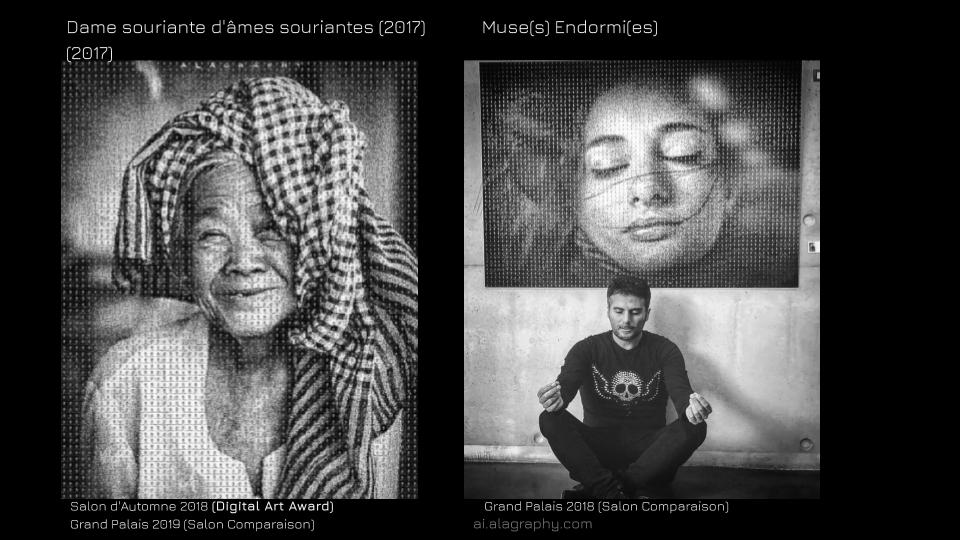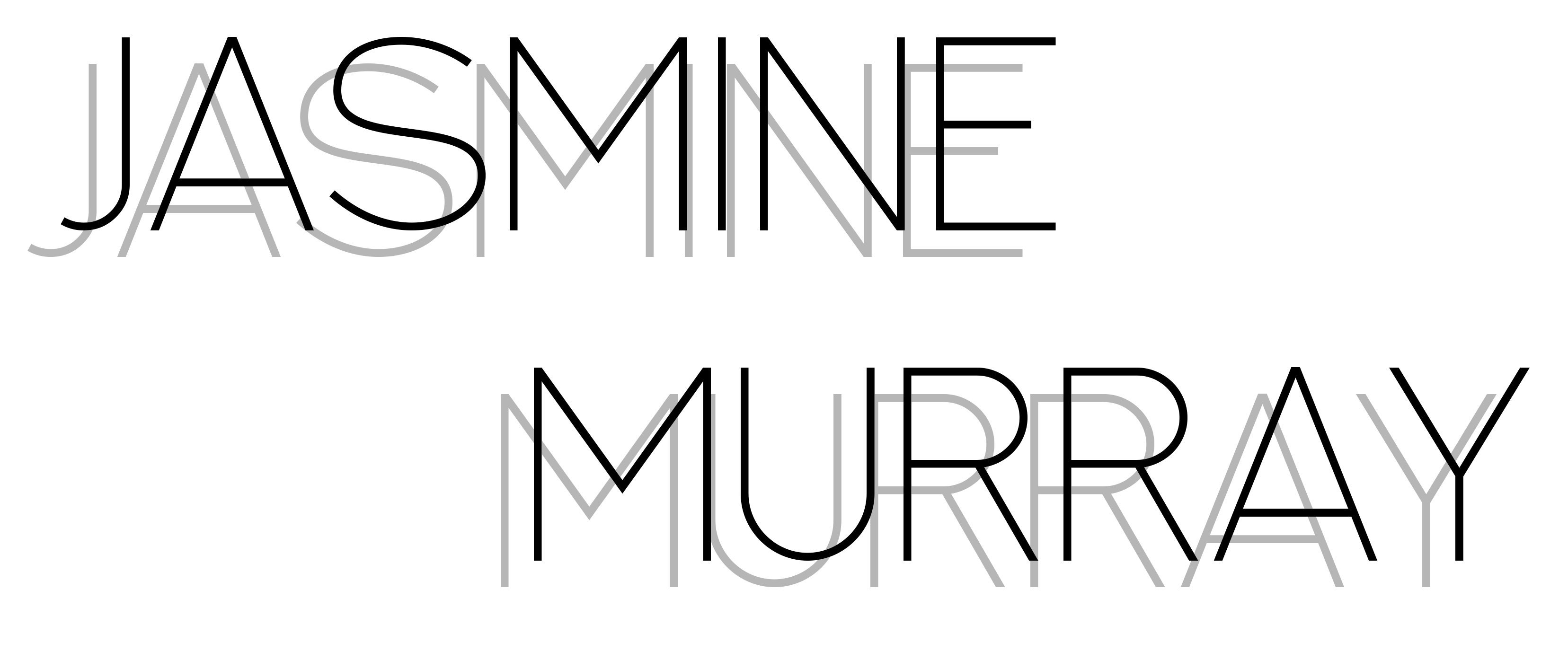GAN (Generative Adversarial Network)

What is GAN? is a method of machine learning designed by Goodfellow et al in 2014, the premise of which is where two neural networks contests with one another to learn to generate new data. The most profilic are GAN trained generated photographs and artwork which have varying degrees of success, in regards to looking authentic. GAN generated images have generated controversy in part mired by it’s association with Deep Fakes (a topic addressed and researched in Informing Contexts Week 8) A prominent artist in the field of GAN AI portraits is ALAgrAphy (Figure 1) who creates artwork of people who don’t exist, may never have existed and will never exist in the future He states his art symbolizes:
“…all genders, races, ethnicities and religions, amply demonstrating that people are more alike than they may think and all are united in a common humanity.”
ALAgrAphy (2018)
/cdn.vox-cdn.com/uploads/chorus_asset/file/15505561/klingemann_gif_again.gif)
The possibilities with GAN generated portraits allows, for an almost endless stream of images, each unique. Klingemann in his series Memories of Passersby I (Figure 2) has arguably produced the ultimate example of what GAN generated image can produce, by creating what Vincent, in 2019, describes as being a lava lamp made of human faces, where each image morphs seamlessly into its successor.

Another example of how GAN can produce endless stream of images can be found in an article by Jerry Wei, who goes as far as explaing in a simple diagram (Figure 3) just how he has used GAN to generate the images, he starts by input data (in this case shoes) generating images over and over again until the output has generated something which resembles a shoe. (A more complex summary on how GAN works can be found on Lyrn.Ai)

However the most prolific GAN based project, has to be Nvidia’s STYLEGANs or rather Philip Wang’s use of the project This Person Does Not Exist (Figure 5), which generates thousands of portraits of people who have never existed in real life. It’s this particular project when has drawn the ire and most comparison to that of deep fakes in part due to people controversially using the people featured as profile photos on sites such as Facebook and Linkedin, with a story breaking the year of Wang’s launch of a fake Linkedin profile that AP (Satter, R. 2019) deemed to have been spy intelligence driven.
Hallmarks of GAN generated imagery include: being a close crop of the face, with an indistinct background, artifacts, halo/paintery effect around hair on an individuals face, smudges and drip marks to the face, heterochromatic or cockeyed eyes and peculiar effects to the ears and any facial jewellery. Examples of these flaws can be found on the Which Face is Real? website, as well as in Generated Photos stock imagery. GAN generated photography is not solely limited to human faces with the past few years springing up a plethora of content, with varying levels of succcess from This Horse Does Not Exist (Figure 6) and This Cat Does Not Exist (Figure 7) which produces largely a very glitched reality of what a horse or cat should look like with elements of the horse or cat missing such as rear legs, mutated figures with 2 heads and six legs, and glitchy distorted feet from This Foot Does Not Exist (Figure 8), to more realistic less glitched outcomes from generators such as These Nudes Do Not Exist which literally generates women naked who do not exist.

AI Fashion Models
The rise of GAN technology has created over the past few years AI supermodels, from firms such as Datagrid (Figure 9) which showcases: “full-body model automatic generation AI that automatically generates full-body images of non-existent people” (Datagrid, 2019), the Diigitals (Figure 10), which was created as an expanse on work first initiated by Cameron-James Wilson, former fashion photographer now CEO of Diigitals, who in 2017 introduced an AI generated model to instagram called Shudu. Much like the GAN images discussed above, AI supermodels provokes an uncanny response when viewing the images, the sense that the reality is not quite real and something is fake but not knowing what is missing.


Another example is lilmiquela (Figure 11) whose images could almost be fooled for just being an ultra-edited and curated instagram feed of a young millennial or older generation Z woman. So much so people have questioned whether she is a robotic creation.

References
Figures
Figure 1 ALAgrAphy (2017-) from the series AI Art. [Online] Available from: https://alahay.org/gallery/AI.html [Accessed 01/07/2020]
Figure 2 Klingemann, M. (2019) Memories of Passersby I. [Online] Available from: https://www.theverge.com/2019/3/5/18251267/ai-art-gans-mario-klingemann-auction-sothebys-technology [Accessed 01/07/2020]
Figure 3 Wei, J. (2018) A Generative Adversarial Network. [Online] Available from: https://towardsdatascience.com/generating-shoe-designs-with-deep-learning-5dde432a23b8 [Accessed 01/07/2020]
Figure 4 Karras, T. Laine, S. Aila, T. (2019) A Style-Based Generator Architecture for Generative Adversarial Networks [Online] Available from: https://www.youtube.com/watch?v=kSLJriaOumA&feature=youtu.be [Accessed 02/07/2020]
Figure 5 Wang, P. (2019-) Screenshot from This Person Does Not Exist. [Online] Available from: http://thispersondoesnotexist.com/ [Accessed 02/07/2020]
Figure 6 This Horse Does Not Exist (2019-) GAN generated image. [Online] Available from: https://thishorsedoesnotexist.com/ [Accessed 03/07/2020]
Figure 7 This Cat Does Not Exist (2019-) GAN generated image. [Online] Available from: https://thiscatdoesnotexist.com/ [Accessed 03/07/2020]
Figure 8 This Foot Does Not Exist (2020-) Text message screenshot from Vice: Gault, M. [Online] Available from: https://www.vice.com/en_us/article/dyg8xz/this-website-texts-you-ai-generated-foot-pics and https://thisfootdoesnotexist.com/ [Accessed 03/07/2020]
Figure 9 Datagrid (2019) 【データグリッド】全身モデル自動生成AI | [DataGrid] Model generation AI. [Online] Available from: https://www.youtube.com/watch?v=8siezzLXbNo [Accessed 03/07/2020]
Figure 10 Diigitals (2018-) Dagny. [Online] Available from: https://www.thediigitals.com/dagny [Accessed 02/07/2020]
Figure 11 lilmiquela (2020) DUDE: StOp WritinG sOnGs AbOuT oUr ReLaTiOnShIp ME: Then stop lying to the beat… [Online] Available from: https://www.instagram.com/p/CCRhLArnm5B/ [Accessed 03/07/2020]
Bibliography
ALAgrAphy (2018) Medium: ARTificial Intelligence Enters the History of Art After Cubism and Fauvism. [Online] Available from: https://medium.com/@alagraphy/aiart-3874186a9a6 [Accessed 01/07/2020]
ALAgrAphy (2019) Medium: This Person Does Not Exist. Neither Will Anything Eventually with AI. [Online] Available from: https://medium.com/@alagraphy/aiart-3874186a9a6 [Accessed 01/07/2020]
Christian, J. (2019) Futurism: The Byte. Astounding AI Guesses What You Look Like Based on Your Voice. [Online] Available from: https://futurism.com/the-byte/ai-guesses-appearance-voice [Accessed 01/07/2020]
Datagrid (2019) 【データグリッド】全身モデル自動生成AI | [DataGrid] Model generation AI. [Online] Available from: https://datagrid.co.jp/en/creative-ai/ and https://www.youtube.com/watch?v=8siezzLXbNo [Accessed 03/07/2020]
Icons8 (2019) Generated Photos. [Online] Available from: https://generated.photos/ [Accessed 02/07/2020]
Goodfellow, I.J. Pouget-Abadie, J. Mirza, M. Xu, B. Warde-Farley, D. Ozair, S. Courville, A. Bengio, Y. (2014) Generative Adversarial Nets. [Online] Available from: https://papers.nips.cc/paper/5423-generative-adversarial-nets.pdf [Accessed 01/07/2020]
Horev, R. (2018) Lyrn AI: Style-based GANs – Generating and Tuning Realistic Artificial Faces. [Online] Available from: https://www.lyrn.ai/2018/12/26/a-style-based-generator-architecture-for-generative-adversarial-networks/ [Accessed 02/07/2020]
Karras, T. Laine, S. Aila, T. (2019) A Style-Based Generator Architecture for Generative Adversarial Networks [Online] Available from: https://www.youtube.com/watch?v=kSLJriaOumA&feature=youtu.be and https://arxiv.org/pdf/1812.04948.pdf (update: https://arxiv.org/pdf/1912.04958.pdf)[Accessed 02/07/2020]
Murray, J. (2020) Informing Contexts: Week 8: Responses and Responsibilities – Research. [Online] Available from: https://jasmphotography.wordpress.com/2020/03/19/week-8-responses-and-responsibilities-2/ [Accessed 01/07/2020]
Satter, R. (2019) AP Experts: Spy used AI-generated face to connect with targets. [Online] Available from: https://apnews.com/bc2f19097a4c4fffaa00de6770b8a60d [Accessed 03/07/2020]
These Nudes Do Not Exist (2020-) [Online] Available from: https://thesenudesdonotexist.com [Accessed 03/07/2020]
Vincent, J. (2019) The Verge: A never-ending stream of AI art goes up for auction. [Online] Available from: https://www.theverge.com/2019/3/5/18251267/ai-art-gans-mario-klingemann-auction-sothebys-technology [Accessed 01/07/2020]
Wei, J. (2018) Medium, towards data science: Generating Shoe Designs with Machine Learning. [Online] Available from: https://towardsdatascience.com/generating-shoe-designs-with-deep-learning-5dde432a23b8 [Accessed 01/07/2020]
West, J. & Bergstrom, C. (2019) Which face is real? [Online] Available from: http://whichfaceisreal.com/learn.html [Accessed 03/07/2020]
Wong, C. (2019) CDOTrends: The Rise of AI Supermodels. [Online] Available from: https://www.cdotrends.com/story/14300/rise-ai-supermodels?refresh=auto [Accessed 03/07/2020]
Zakharov, E. Shysheya, A. Burkov, E. & Lempitsky, V. (2019) Few-Shot Adversarial Learning of Realistic Neural Talking Head Models. [Online] Available from: https://arxiv.org/pdf/1905.08233.pdf and https://www.youtube.com/watch?v=p1b5aiTrGzY [Accessed 03/07/2020]
Other GAN driven sites:
This Artwork does not exist (2019-) [Online] Available from: https://thisartworkdoesnotexist.com/ [Accessed 01/07/2020]
This Rental does not exist (2019-) [Online] Available from: https://thisrentaldoesnotexist.com/ [Accessed 01/07/2020]
This Resume does not exist (2019-) [Online] Available from: https://thisresumedoesnotexist.com/ [Accessed 01/07/2020]

2 thoughts on “Week 5: Three ‘Surfaces’ Research”